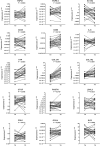Bronchial thermoplasty in severe asthma: a real-world study on efficacy and gene profiling
- PMID: 35534846
- PMCID: PMC9087992
- DOI: 10.1186/s13223-022-00680-4
Bronchial thermoplasty in severe asthma: a real-world study on efficacy and gene profiling
Abstract
Background: Bronchial thermoplasty (BT) is an effective treatment in severe asthma. How to select patients who more likely benefit from BT is an unmet clinical need. Moreover, mechanisms of BT efficacy are still largely unknown. We sought to determine BT efficacy and to identify potential mechanisms of response.
Methods: This retrospective cohort study evaluated clinical outcomes in 27 patients with severe asthma: 13 with T2-high and 14 with T2-low endotype. Expression levels of 20 genes were compared by real-time PCR in bronchial biopsies performed at the third BT session versus baseline. Clinical response was measured based on Asthma Control Questionnaire (ACQ) score < 1.5, asthma exacerbations < 2, oral corticosteroids reduction of at least 50% at 12 months post-BT. Patients were classified as responders when they had at least 2 of 3 outcome measures.
Results: 81% of patients were defined as responders. BT induced a reduction in alpha smooth muscle actin (ACTA2) and an increase in CD68, fibroblast activation protein-alpha (FAP), alpha-1 and alpha-2 type I collagen (COL1A1, COL1A2) gene expression in the majority of patients. A higher reduction in ubiquitin carboxy-terminal-hydrolase L1 (PGP9.5) mRNA correlated with a better response based on Asthma Quality of Life Questionnaire (AQLQ). Lower changes in CD68 and FAP mRNAs correlated with a better response based on ACQ. Lower levels of occludin (OCLN), CD68, connective tissue growth factor (CTGF), higher levels of secretory leukocyte protease inhibitor (SLPI) and lower changes in CD68 and CTGF mRNAs were observed in patients who had less than 2 exacerbations post-BT. Lower levels of COL1A2 at baseline were observed in patients who had ACQ < 1.5 at 12 months post-BT.
Conclusions: BT is effective irrespective of the asthma endotypes and seems associated with airway remodelling. Quantification of OCLN, CD68, CTGF, SLPI, COL1A2 mRNAs could be useful to identify patients with better results.
Trial registration: The study protocol was approved by the Local Ethics Committee (Azienda USL-IRCCS of Reggio Emilia-Comitato Etico Area Vasta Nord of Emilia Romagna; protocol number: 2019/0014076) and all the patients provided written informed consent before participating in the study.
Keywords: Bronchial biopsies; Bronchial thermoplasty; Gene expression; Real-time PCR; Severe asthma; Smooth muscle.
© 2022. The Author(s).
Conflict of interest statement
The authors declare that they have no competing interests.
Figures




References
-
- Corren J. Asthma phenotypes and endotypes: an evolving paradigm for classification. Discov Med. 2013;15(83):243–249. - PubMed
-
- https://ginasthma.org/wp-content/uploads/2021/05/GINA-Main-Report-2021-V... Accessed 28 Dec 2021.
LinkOut - more resources
Full Text Sources
Miscellaneous

